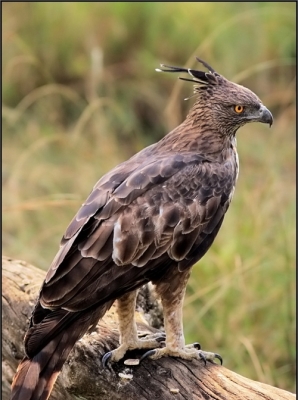
The changeable hawk-eagle (Nisaetus Cirrhatus) is also known as the crested hawk-eagle. It is a large-sized, slender eagle belonging to the family Accipitridae.
Adult eagles are typically brown with longitudinal streaks on the throat and chocolate streaks on the chest. Some subspecies have a crest of four feathers on the head, but this is absent in others; hence the name ‘changeable’ hawk-eagle. Adults have yellow to orange eyes while younger eagles have gray-brown or greenish eyes. All ages have yellow feet with powerful talons.
This eagle is found mainly in India, Bangladesh, Cambodia, Indonesia, Malaysia, Myanmar, Philippines, Sri Lanka, Thailand and Vietnam. It prefers wooded to semi-wooded habitats and eats mammals, birds and reptiles. It perches bolt upright on trees watching for jungle-fowl, rabbits or some small animal to pass by. Upon spotting its hapless prey, it swoops down and carries it away in its formidable talons.
This raptor is not migratory and remains in the same habitat all the year round. Both males and females participate in nest-building together. The nest is often wide and somewhat deep and made of sticks and green leaves, on a tall tree. The female lays a single grayish or white egg, often with reddish-brown spots. The female is in sole charge of incubation and the male is responsible for feeding the female during this time. The incubation period is about 50 days and once the eaglet hatches, it takes about 62 to 68 days to reach the flying stage.
The changeable hawk-eagle is the most widespread of the Asiatic hawk-eagle species and is categorized as a species of ‘Least concern’. However, it is under considerable threat from habitat loss due to deforestation, fragmentation and persecution by humans.
Picture Credit : Google




